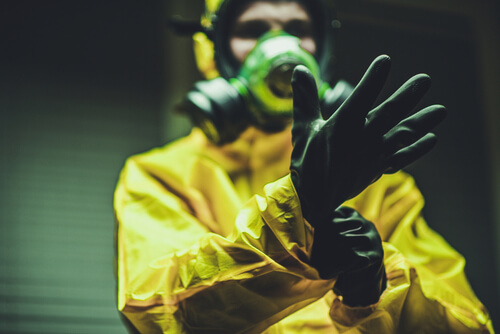In an age of rapid technological advancements, our lives have become entwined with electronics. From the smartphones that connect us to the world to the laptops that power our work, we want the best — and that means an assumption of obsolescence. Part of the nature of our electronic economy is the presumption of waste, called “e-waste” in this context, as we upgrade and replace.
Each of these devices harbors hidden dangers in the form of hazardous materials, commonly known as “hazmat.” For example, batteries laden with heavy metals and mercury-containing components pose significant risks to our environment and health when not disposed of properly.
Let’s dive into the hazardous components of electronics, shed some light on their risks, and explore how proper recycling plays a pivotal role in minimizing these e-waste risks.
The Hazards Lurking in Electronics
Here is a list of the most common hazardous materials associated with electronics and e-waste.
Mercury
Old CRT monitors, fluorescent lamps and other devices often contain highly toxic mercury. If these devices break or leak mercury, it contaminates the environment and accumulates in aquatic systems, where it inevitably finds its way into the food chain.
Lead
Lead is often present in older electronics, especially in the soldering that connects components on circuit boards. Lead can lead to soil and water contamination if not properly handled, and exposure to lead causes developmental and neurological issues, particularly in children.
Cadmium
Cadmium is used in some batteries, connectors and semiconductors. It’s highly toxic and can accumulate in the environment, potentially affecting aquatic life and human health through contaminated water and food.
Chlorofluorocarbons (CFCs)
Older cooling systems and refrigeration units in electronics might contain CFCs, which are harmful to the ozone layer and contribute to climate change.
Brominated Flame Retardants (BFRs)
BFRs are used in plastics and other materials to make electronics fire-resistant. However, these chemicals persist in the environment; some types are considered toxic. They can leach into soil and water, potentially causing adverse health effects.
Arsenic
Arsenic is used in electronic components and can also be found in semiconductors. Exposure to arsenic can lead to various health issues, from skin problems to cardiovascular diseases and even cancer.
PVC (Polyvinyl Chloride)
PVC is commonly used in cables, wires and plastic casings. When PVC is incinerated, it releases dioxins and other harmful pollutants into the air.
Nickel
Nickel is found in various electronic components, including connectors and batteries. Prolonged exposure to nickel can cause skin allergies and respiratory problems.
Phthalates
These chemicals are used in some plastics to increase flexibility. They are known endocrine disruptors and adversely affect human health, particularly reproductive health.
Hexavalent Chromium
This hazardous material is used in some metal finishes and coatings. It can pose a risk to both human health and the environment.
Beryllium
Beryllium is used in some electronics for its electrical and thermal conductivity properties. However, exposure to the dust or fumes leads to lung diseases and other health complications.
Environmental and Health Risks
The improper disposal of hazmat-laden electronics poses significant risks.
Soil and Water Pollution
Hazardous materials seep into the ground and water, contaminating these vital resources. This disrupts ecosystems, affects agriculture and pollutes the water supply.
Airborne Toxins
Incinerating electronics releases hazardous fumes into the air, contributing to air pollution and negatively affecting air quality, particularly in the areas surrounding disposal sites.
Health Impact
Exposure to hazmat can lead to severe health issues like respiratory problems, nervous system disorders and even carcinogenic effects in both humans and animals.
The Role of Proper Electronics Recycling
As an R2 certified recycling company, here are the steps we take in the industry to avoid poisoning our planet and ourselves when it’s time to retire electronics and deal with e-waste:
Safe Extraction
Skilled technicians carefully dismantle devices, segregating hazardous materials from recyclable components.
Material Recovery
Facilities recover valuable materials from electronics, such as metals and plastics, which reduces the need for new resource extraction and can significantly lessen environmental impact.
Hazmat Treatment
Recycling centers employ specialized methods to treat and dispose of hazardous materials in an environmentally friendly manner, preventing their release into the environment.
Regulatory Compliance
Proper electronics recycling adheres to local and international regulations, ensuring that hazardous materials are managed responsibly and legally.
Let RetirePC Guide You to the Next Step, Safely
The hazards embedded within our electronics demand our attention. While these devices offer convenience and connectivity, they also carry the responsibility of proper disposal. Electronics recycling is not just a choice — it’s a crucial step toward safeguarding our environment and health from the perils of hazardous materials.
Entrusting our electronic waste to reputable recycling facilities means we play a pivotal role in mitigating environmental degradation and minimizing the health risks for ourselves and future generations. Join RetirePC in the journey towards responsible electronics recycling. Contact us today for more on our certified recycling services and how we can all contribute to a safer, cleaner world.


